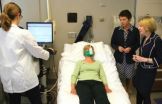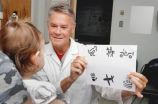(Press-News.org) VIDEO:
Researchers at The Ohio State University Wexner Medical Center have found that women who ate a high-fat meal the day after a stressful event metabolized food more slowly, and the...
Click here for more information.
COLUMBUS, Ohio – A new study in women suggests that experiencing one or more stressful events the day before eating a single high-fat meal can slow the body's metabolism, potentially contributing to weight gain.
Researchers questioned study participants about the previous day's stressors before giving them a meal consisting of 930 calories and 60 grams of fat. The scientists then measured their metabolic rate – how long it took the women to burn calories and fat – and took measures of blood sugar, triglycerides, insulin and the stress hormone cortisol.
On average, the women in the study who reported one or more stressors during the previous 24 hours burned 104 fewer calories than nonstressed women in the seven hours after eating the high-fat meal – a difference that could result in weight gain of almost 11 pounds in one year.
The stressed women also had higher levels of insulin, which contributes to the storage of fat, and less fat oxidation – the conversion of large fat molecules into smaller molecules that can be used as fuel. Fat that is not burned is stored.
"This means that, over time, stressors could lead to weight gain," said Jan Kiecolt-Glaser, professor of psychiatry and psychology at The Ohio State University and lead author of the study. "We know from other data that we're more likely to eat the wrong foods when we're stressed, and our data say that when we eat the wrong foods, weight gain becomes more likely because we are burning fewer calories."
Previous research also has shown that people who experience stress and other mood disruptions are at higher risk of becoming overweight or obese. This study, the researchers say, appears to illustrate at least one mechanism behind that connection.
The research is published in the journal Biological Psychiatry.
The study was conducted in 58 women, average age 53, and included two admissions to Ohio State's Clinical Research Center for daylong analyses. To regulate their food intake for 24 hours before eating the high-fat meal, researchers supplied the participants with three standardized meals on the previous day and instructed them to fast for 12 hours before reporting for their study visit.
On the day of admission, the participants completed several questionnaires to assess their depressive symptoms and physical activity and were interviewed about stressful events on the prior day. Thirty-one women reported at least one prior day stressor on one visit and 21 reported stressors at both visits. Six women reported no stressors.
Most of the reported stressors were interpersonal in nature: arguments with co-workers or spouses, disagreements with friends, trouble with children or work-related pressures.
The research meal consisted of eggs, turkey sausage, biscuits and gravy – roughly equivalent in calories and fat to a loaded two-patty hamburger and French fries at a fast-food restaurant. Participants were required to eat the entire meal within 20 minutes.
"This is not an extraordinary meal compared to what many of us would grab when we're in a hurry and out getting some food," said Kiecolt-Glaser, also director of the Institute for Behavioral Medicine at Ohio State.
The control for comparison in this randomized trial was that one meal contained saturated fat and another was high in a different kind of fat: sunflower oil containing monounsaturated fat, which is associated with a variety of health benefits.
"We suspected that the saturated fat would have a worse impact on metabolism in women, but in our findings, both high-fat meals consistently showed the same results in terms of how stressors could affect their energy expenditure," said Martha Belury, professor of human nutrition at Ohio State and a co-author of the study.
Before the meal, participants rested for 30 minutes and their energy expenditure – or calories burned by converting food to energy – was tested during that time. After they ate their meal, their metabolic rate was tested for 20 minutes of every hour for the next seven hours. Researchers obtained this data by using equipment that measured inhaled and exhaled airflow of oxygen and carbon dioxide.
"By measuring the gas exchange, we can determine their metabolic rate: how much energy their body needs during the time being measured," Belury said. "The participants burned fewer calories over the seven hours after the meal when they had a stressor in their life the day before the meal."
Researchers also took multiple blood samples "so we could follow throughout the day what was happening metabolically after eating the high-fat meal," Kiecolt-Glaser said.
The stressors' effects of increasing insulin had a time element: Insulin spiked soon after the high-fat meal was consumed and then decreased to roughly match insulin levels in nonstressed women after another 90 minutes.
A history of depression alone did not affect metabolic rate, but depression combined with previous stressors led to a steeper immediate rise in triglycerides after the meal. Triglycerides are a form of fat in the blood, and high levels are considered a risk for cardiovascular disease.
"With depression, we found there was an additional layer. In women who had stress the day before and a history of depression, triglycerides after the meal peaked the highest," Kiecolt-Glaser said. "The double whammy of past depression as well as daily stressors was a really bad combination."
The researchers are reluctant to extend these findings to men because men tend to have more muscle than women, which would affect their metabolic rate, Belury said.
But the findings do offer one more motivation to keep healthful foods nearby.
"We know we can't always avoid stressors in our life, but one thing we can do to prepare for that is to have healthy food choices in our refrigerators and cabinets so that when those stressors come up, we can reach for something healthy rather than going to a very convenient but high-fat choice," Belury said.
INFORMATION:
This research was supported by grants from the National Cancer Institute and the National Institutes of Health, including funding of Ohio State's Center for Clinical and Translational Science, home to the Clinical Research Center.
Additional co-authors include Diane Habash of the School of Health and Rehabilitation Sciences, Rebecca Andridge and Juan Peng of the College of Public Health Division of Biostatistics, and William Malarkey of the Department of Internal Medicine, all at Ohio State; and Christopher Fagundes of MD Anderson Cancer Center.
Contact: Jan Kiecolt-Glaser, (614) 293-0549; Janice.Kiecolt-Glaser@osumc.edu
Written by Emily Caldwell, (614) 292-8310; Caldwell.151@osu.edu END
Weighty issue: Stress and high-fat meals combine to slow metabolism in women
Study estimates daily effect could add up to nearly 11 pounds in a year
2014-07-14
ELSE PRESS RELEASES FROM THIS DATE:
Prehistoric 'bookkeeping' continued long after invention of writing
2014-07-14
An archaeological dig in southeast Turkey has uncovered a large number of clay tokens that were used as records of trade until the advent of writing, or so it had been believed.
But the new find of tokens dates from a time when writing was commonplace – thousands of years after it was previously assumed this technology had become obsolete. Researchers compare it to the continued use of pens in the age of the word processor.
The tokens – small clay pieces in a range of simple shapes – are thought to have been used as a rudimentary bookkeeping system in prehistoric ...
The Lancet Neurology: Post-concussion 'return to play' decision for footballers should be made solely by doctors, says new editorial
2014-07-14
An editorial published today in The Lancet Neurology calls for sports authorities to take into consideration the long term neurological problems that repeated concussions can cause.
Cerebral concussion is the most common form of sports-related traumatic brain injury (TBI), and the long-term effects of repeated concussions may include dementia, amyotrophic lateral sclerosis, and other neurological disorders, say the journal editors.
However, what is perhaps more concerning, is that even when the symptoms of concussion are delayed, or if they come and go quickly, neurological ...
The Lancet Oncology: Differences in treatment likely to be behind differing survival rates for blood cancers between regions within Europe
2014-07-14
Failure to get the best treatment and variations in the quality of care are the most likely reasons why survival for blood cancer patients still varies widely between regions within Europe, according to the largest population-based study of survival in European adults to date, published in The Lancet Oncology.
"The good news is that 5-year survival for most cancers of the blood has increased over the past 11 years, most likely reflecting the approval of new targeted drugs in the early 2000s such as rituximab for non-Hodgkin lymphoma and imatinib for chronic myeloid leukaemia", ...
MUHC researcher unveils novel treatment for a form of childhood blindness
2014-07-14
This news release is available in French.
Montreal, July 13, 2014 — An international research project, led by the Research Institute of the McGill University Health Centre (RI-MUHC) in Montreal, reports that a new oral medication is showing significant progress in restoring vision to patients with Leber congenital amaurosis (LCA). Until now, this inherited retinal disease that causes visual impairment ranging from reduced vision to complete blindness, has remained untreatable. The study is published today in the scientific journal The Lancet.
"This is the first ...
Australia drying caused by greenhouse gases
2014-07-13
NOAA scientists have developed a new high-resolution climate model that shows southwestern Australia's long-term decline in fall and winter rainfall is caused by increases in manmade greenhouse gas emissions and ozone depletion, according to research published today in Nature Geoscience.
"This new high-resolution climate model is able to simulate regional-scale precipitation with considerably improved accuracy compared to previous generation models," said Tom Delworth, a research scientist at NOAA's Geophysical Fluid Dynamics Laboratory in Princeton, N.J., who helped ...
Deep within spinach leaves, vibrations enhance efficiency of photosynthesis
2014-07-13
ANN ARBOR – Biophysics researchers at the University of Michigan have used short pulses of light to peer into the mechanics of photosynthesis and illuminate the role that molecule vibrations play in the energy conversion process that powers life on our planet.
The findings could potentially help engineers make more efficient solar cells and energy storage systems. They also inject new evidence into an ongoing "quantum biology" debate over exactly how photosynthesis manages to be so efficient.
Through photosynthesis, plants and some bacteria turn sunlight, water and ...
Researchers discover boron 'buckyball'
2014-07-13
PROVIDENCE, R.I. (Brown University) -- The discovery 30 years ago of soccer-ball-shaped carbon molecules called buckyballs helped to spur an explosion of nanotechnology research. Now, there appears to be a new ball on the pitch.
Researchers from Brown University, Shanxi University and Tsinghua University in China have shown that a cluster of 40 boron atoms forms a hollow molecular cage similar to a carbon buckyball. It's the first experimental evidence that a boron cage structure—previously only a matter of speculation—does indeed exist.
"This is the first time that ...
Study finds cause of mysterious food allergy, suggests new treatment strategy
2014-07-13
New research in Nature Genetics identifies a novel genetic and molecular pathway in the esophagus that causes eosinophillic esophagitis (EoE), opening up potential new therapeutic strategies for an enigmatic and hard-to-treat food allergy.
EoE is a chronic inflammatory disorder of the esophagus. The condition is triggered by allergic hypersensitivity to certain foods and an over-accumulation in the esophagus of white blood cells called eosinophils (part of the body's immune system). EoE can cause a variety of gastrointestinal complaints including reflux-like symptoms, ...
Antibody halts cancer-related wasting condition
2014-07-13
BOSTON – New research raises the prospect of more effective treatments for cachexia, a profound wasting of fat and muscle occurring in about half of all cancer patients, raising their risk of death, according to scientists from Dana-Farber Cancer Institute.
Many strategies have been tried to reverse the condition, which may cause such frailty that patients can't endure potentially life-saving treatments, but none have had great success.
Scientists reporting in the July 13 advanced online edition of Nature, led by Bruce Spiegelman, PhD, demonstrated that in mice bearing ...
Stanford researchers invent nanotech microchip to diagnose type-1 diabetes
2014-07-13
An inexpensive, portable, microchip-based test for diagnosing type-1 diabetes could improve patient care worldwide and help researchers better understand the disease, according to the device's inventors at the Stanford University School of Medicine.
Described in a paper to be published online July 13 in Nature Medicine, the test employs nanotechnology to detect type-1 diabetes outside hospital settings. The handheld microchips distinguish between the two main forms of diabetes mellitus, which are both characterized by high blood-sugar levels but have different causes ...
LAST 30 PRESS RELEASES:
Innovative techniques enable Italy’s first imaging of individual trapped atoms
KIER successfully develops Korea-made “calibration thermoelectric module” for measuring thermoelectric device performance
Diversifying US Midwest farming for stability and resilience
Emphasizing immigrants’ deservingness shifts attitudes
Japanese eels, climate change, and river temperature
Pusan National University researchers discover faster, smarter heat treatment for lightweight magnesium metals
China’s 2024 Gastroenterology Report: marked progress in endoscopy quality and disease management
Pusan National University researchers uncover scalable method for ultrahigh-resolution quantum dot displays
Researchers use robotics to find potential new antibiotic among hundreds of metal complexes
Gut bacteria changes at the earliest stages of inflammatory bowel disease
Scientists develop new way to “listen in” on the brain’s hidden language
Brain research: “Pulse generators” grow and shrink as memories are formed
For teens, any cannabis use may have impact on emotional health, academic performance
School meals could unlock major gains for human and planetary health
Menopause hormone therapy does not appear to impact dementia risk
Signature patterns of brain activity may help predict recovery from traumatic brain injury
Dresden study uncovers new key mechanism in cancer cells
New species are now being discovered faster than ever before, study suggests
Cannabis-based products show limited short-term benefit for chronic pain, with increased risk of adverse effects
Cannabis products with more THC slightly reduce pain but cause more side effects
Clearing the brain of aging cells could aid epilepsy and reduce seizures
Brain injuries linked with potential risk of suicide, new study finds
New technique lights up where drugs go in the body, cell by cell
New study finds movement of fishing fleets can reveal shifts in marine ecosystems
Embargoed: New evidence points to potential treatment for vascular dementia
Study uncovers disrupted brain balance in alcohol dependence
Working in groups can help Republicans and Democrats agree on controversial content moderation online
Structural findings reveal how distinct GPCR ligands create different levels of activation
Anything-goes “anyons” may be at the root of surprising quantum experiments
UC review: Maximizing workplace opportunity for veterans
[Press-News.org] Weighty issue: Stress and high-fat meals combine to slow metabolism in womenStudy estimates daily effect could add up to nearly 11 pounds in a year






